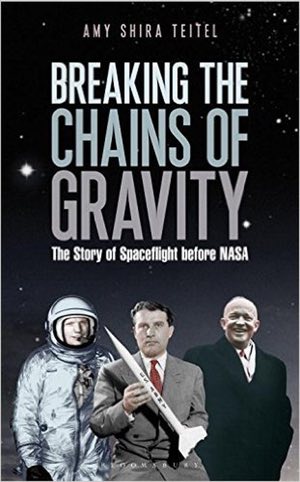Review: Breaking the Chains of Gravityby Jeff Foust
|
| A good history book should provide the reader with new insights about the topic, either through new evidence or a critical reexamination and reevaluation of existing evidence. This book does neither. |
As the “before NASA” in the subtitle suggests, the book focuses more on American efforts in spaceflight. Teitel starts, though, with German rocket efforts, from the early amateur efforts in the late 1920s and 1930s through the development of the V-2 rocket used by Nazi Germany. She follows Wernher von Braun and his team to America, and the subsequent development of rocket projects leading up to the launch of Explorer 1 in 1958, along with separate efforts in the development of rocket planes. Parallel Soviet efforts aren’t discussed in the book other than the effect they had on American plans; Sergei Korolev, whose influence on spaceflight was at least as great as von Braun, is never mentioned.
Many readers here know Teitel for allegations of plagiarism in several articles she wrote for online publications (see “Plagiarism in several space history articles”, The Space Review, November 4, 2013). Those allegations, which resulted those stories being removed from those publications’ sites, did not hurt her career in the long term: she writes, and does videos, for other publications in addition to this book, and was a self-described “embedded journalist” during the New Horizons flyby of Pluto last year. Moreover, there are no claims that any sections of this book were plagiarized from other publications (although a thorough examination of the book is beyond the scope of this review.)
There is, though, another issue about the book’s originality. A good history book should provide the reader with new insights about the topic, either through new evidence or a critical reexamination and reevaluation of existing evidence. Breaking the Chains of Gravity, though, does neither. Teitel leans heavily on secondary sources, like biographies and other historical accounts (Michael Neufeld’s von Braun biography and Dennis Piszkiewicz’s The Nazi Rocketeers are heavily referenced in the book’s early chapters, for example.) There is also no overarching theme or thesis to the book, such as evaluating the roles von Braun and others played in the opening of the Space Age, other than, perhaps, there were multiple efforts in the 1950s, something most people with even a basic understanding of space history already know.
Breaking the Chains of Gravity is, at best, a book for people unfamiliar with the pre-history of spaceflight, people who might have heard of von Braun and the V-2 but don’t know how it fits into the events that led to the launch of the first American satellite. The book, though, goes little beyond that, including no critical reinterpretation of those events or their significance. There is still, arguably, a lot to learn from that era and how it influence spaceflight to this day, but this book adds little to that effort.
